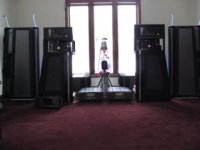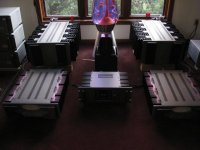About the O3 problem.
last year when I tuned a plasma tweeter with 6P13(6DQ6?) , I smelled the O3.
But this year I change the tube to PL519, no O3 was smelled.
I estimated that the RF voltage only several hundred volts at the flame, so no O3 problem again.
last year when I tuned a plasma tweeter with 6P13(6DQ6?) , I smelled the O3.
But this year I change the tube to PL519, no O3 was smelled.
I estimated that the RF voltage only several hundred volts at the flame, so no O3 problem again.
Hill Plasma with Apogee Ribbon speakers
How about this for a combo, the Hill Plasma with Apogee
scintillas, stages. Works great, but the helium is quite
expensive for the plasma units.
There have been several threads on plasma tweeters here!
Do a search?
There was a recent one that showed promising results.
One caveat:
PLEASE GROUND AND SHEILD THE TWEETER!!
That's because it is an emitter of RF noise, noise that can interfere with important and unimportant services and equipment.
I'll agree with Nelson Pass, one of the most impressive speakers I can recall hearing was the Hill Plasmatronics, that is from the xover to the plasma section up (the bass was less than good).
_-_-bear
How about this for a combo, the Hill Plasma with Apogee
scintillas, stages. Works great, but the helium is quite
expensive for the plasma units.
Attachments
There is some evidence, that the principle of operation
of a tweeter does not cause any audible differences in
quality. Most of the audible differences are due to
different dispersion characteristics and frequency
response.
If room reverberation and differences in frequency
response (amplitude and phase) can be diminished/
ruled out by experimental setting, listeners may e.g.
not be able to distinguish a ribbon from a dome tweeter.
A point which makes me wondering about the attractivity
of plasma designs. Hard to believe there are proven
acoustical reasons. There may be different ones ...
http://www.ak.tu-berlin.de/fileadmin/a0135/Magisterarbeiten/Andreas_Rotter_MagA.pdf
of a tweeter does not cause any audible differences in
quality. Most of the audible differences are due to
different dispersion characteristics and frequency
response.
If room reverberation and differences in frequency
response (amplitude and phase) can be diminished/
ruled out by experimental setting, listeners may e.g.
not be able to distinguish a ribbon from a dome tweeter.
A point which makes me wondering about the attractivity
of plasma designs. Hard to believe there are proven
acoustical reasons. There may be different ones ...
http://www.ak.tu-berlin.de/fileadmin/a0135/Magisterarbeiten/Andreas_Rotter_MagA.pdf
How about this for a combo, the Hill Plasma with Apogee
scintillas, stages. Works great, but the helium is quite
expensive for the plasma units.
Nice setup! Did you get my PM by chance? (Private Message - upper right hand corner of the screen.)
There is some evidence, that the principle of operation
of a tweeter does not cause any audible differences in
quality. Most of the audible differences are due to
different dispersion characteristics and frequency
response.
This is my finding.
I built a plasma tweeter, powered by a screen driven pentode if I remember correctly. It sounded quite free of physical problems, as expected, but this didn't turn out to be the Holy grail I thought it would.
I could still hear the electronics, and the dispersion was not helpful. I did however manage to prove to myself that the Revelator domes I was using at the time had little wrong with them for what they were. They sounded quite similar to the plasma in nearfield listening.
Intresting !
The problem with most of the demos that I have seen so far is that the signal seems to get distorted because of over driving to trying and get some SPL's out of it.
It takes alot of displacement to get a decent SPL level even as low as 1khz.
But I feel it can be done.
Just a few thoughts. jer
The problem with most of the demos that I have seen so far is that the signal seems to get distorted because of over driving to trying and get some SPL's out of it.
It takes alot of displacement to get a decent SPL level even as low as 1khz.
But I feel it can be done.
Just a few thoughts. jer
- Status
- Not open for further replies.
- Home
- Loudspeakers
- Planars & Exotics
- plasma tweeter - ion tweeter


